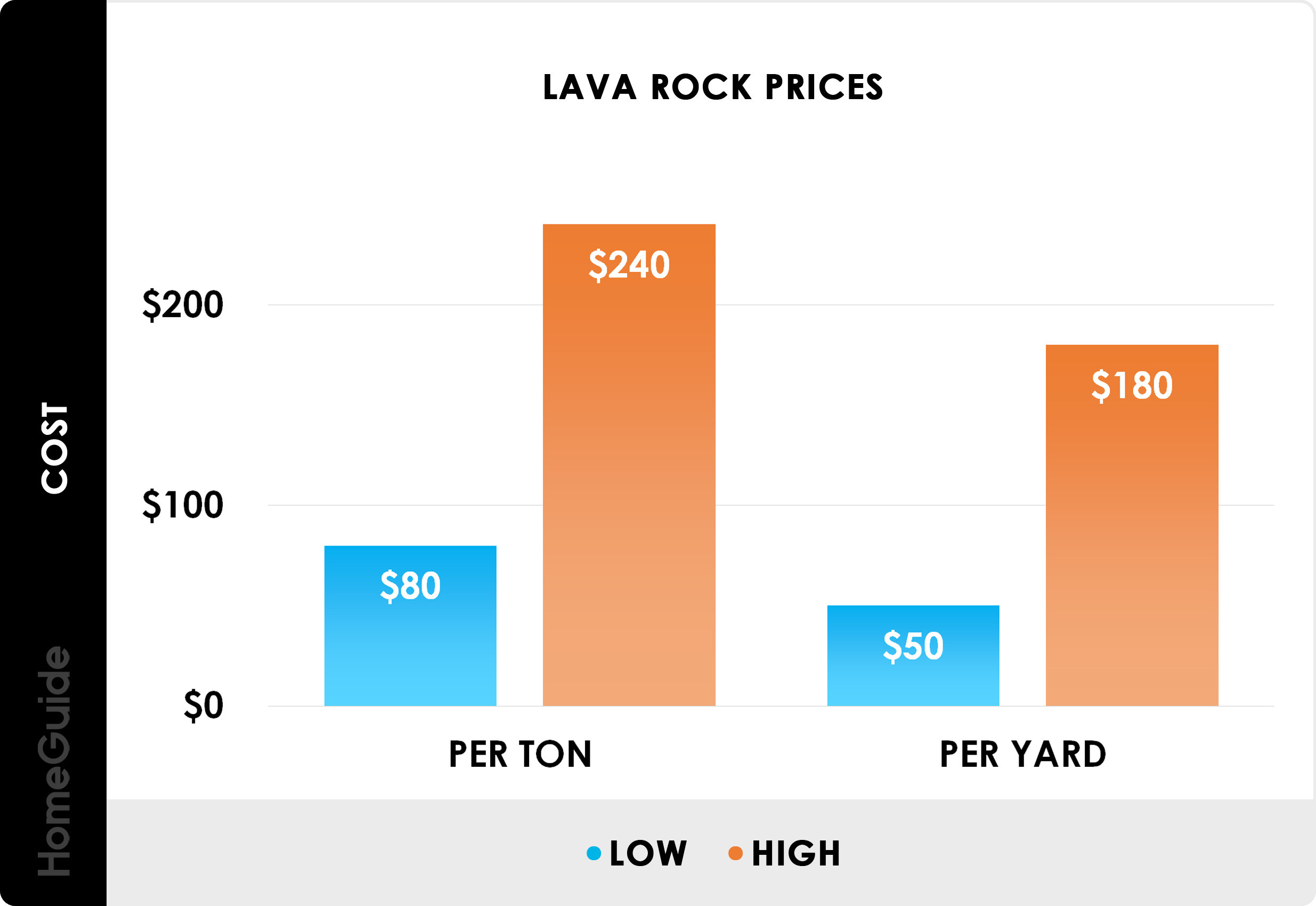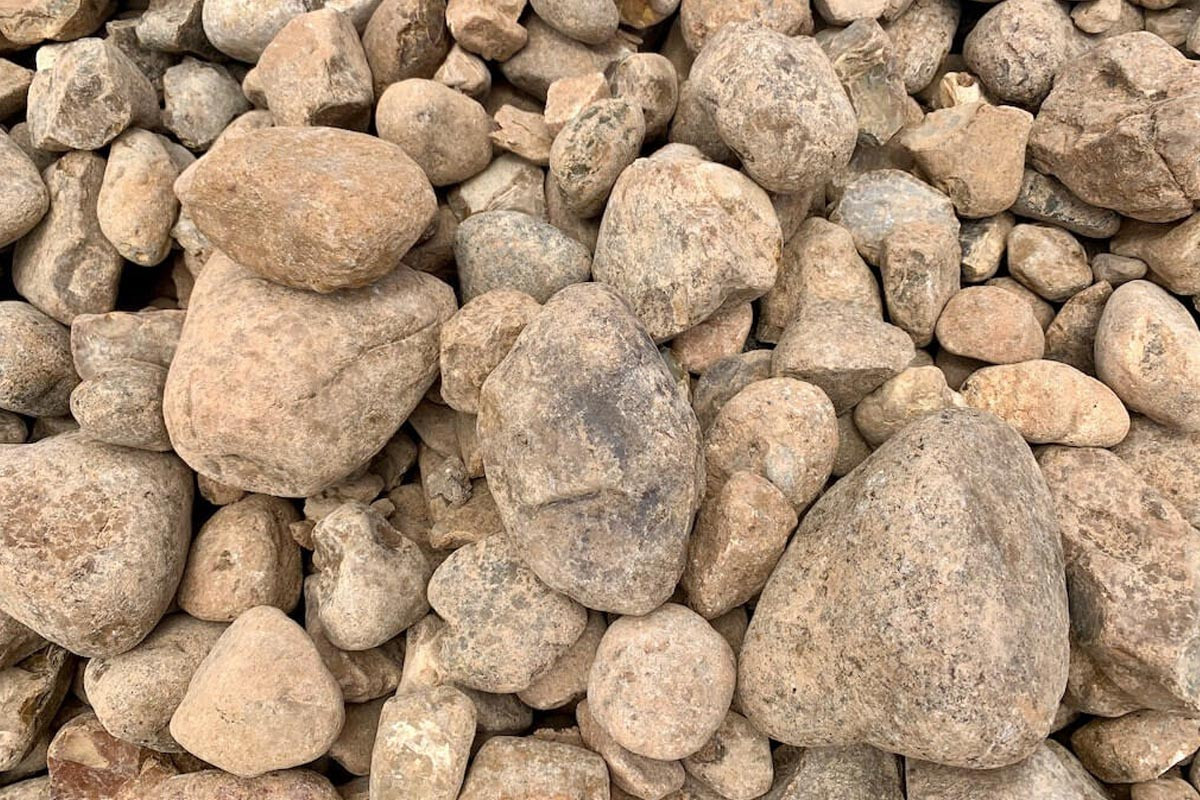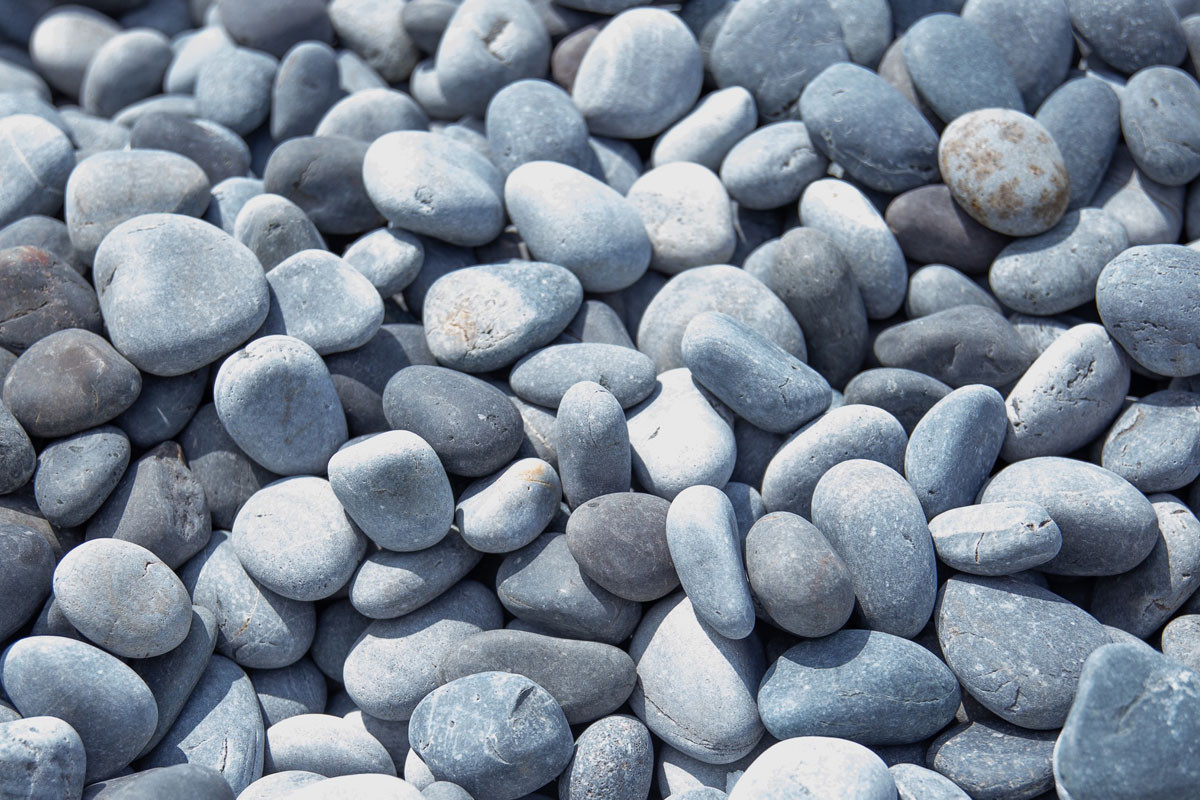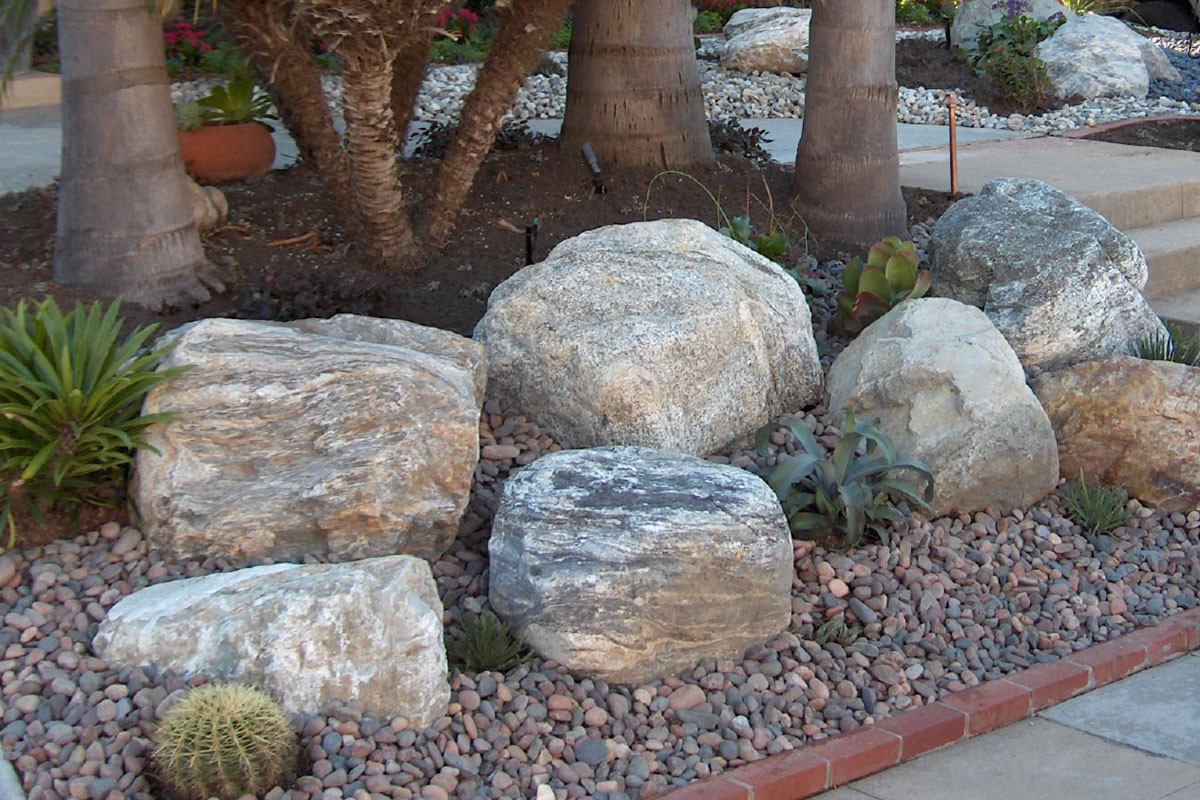River rock ground cover can dramatically enhance your outdoor spaces, and understanding how much coverage you’ll get from a yard is essential for accurate project planning. At rockscapes.net, we’re experts in all things landscaping rock. This guide will delve into the coverage you can expect from a yard of river rock, exploring various factors that influence it, and providing tips to maximize your investment, ensuring you achieve the beautiful and functional landscape you envision.
1. Understanding River Rock Coverage: The Basics
Generally, one cubic yard of river rock will cover approximately 75 to 170 square feet at a depth of 2 to 4 inches. The exact coverage hinges on a few key elements, like the size of the river rocks and the depth of the layer you’re aiming for.
To determine the amount of river rock you need, it’s essential to consider these factors:
- Rock Size: Smaller rocks will pack more densely, covering a larger area compared to larger rocks.
- Desired Depth: A thicker layer requires more material but offers better weed suppression and erosion control.
- Project Type: Different projects, such as pathways, gardens, or drainage solutions, may require varying depths and rock sizes.
2. Factors Influencing River Rock Coverage
Several factors affect how far a yard of river rock will stretch. Here’s a detailed look:
2.1. River Rock Size and Shape
River rock commonly comes in sizes ranging from 3/8 inch to 5 inches. Smaller sizes (3/8 to 3/4 inch) are excellent for pathways and playgrounds due to their smooth, even layers. Larger sizes (1 to 3 inches) are suitable for water features and garden top dressing. According to the Arizona State University’s School of Earth and Space Exploration, smaller, smoother rocks like those found near the Salt River in Arizona, tend to compact more efficiently, increasing coverage.
2.2. Layer Depth
The depth of the river rock layer significantly impacts the amount of coverage you’ll achieve. Common depths include:
- 2 inches: Suitable for purely decorative purposes or as a thin top layer. A yard of river rock will cover approximately 160 to 170 square feet at this depth.
- 3 inches: Ideal for weed suppression and light erosion control. At this depth, a yard of river rock will cover approximately 100 to 110 square feet.
- 4 inches: Best for significant erosion control and drainage solutions. A yard of river rock will cover approximately 75 to 85 square feet at this depth.
2.3. Compaction
Compaction refers to how tightly the river rocks settle together. Over time, natural settling and compaction can reduce the coverage area.
2.4. Underlying Surface
The type of surface beneath the river rock can also influence coverage. For example, if you’re covering an uneven surface, you’ll likely need more rock to achieve a uniform appearance.
2.5. Waste and Overlap
Always account for potential waste and overlap when estimating how much river rock you need. It’s better to have a little extra than to run short in the middle of your project.
3. Calculating River Rock Needs: Step-by-Step
Calculating the amount of river rock needed involves a few simple steps:
3.1. Measure the Area
Measure the length and width of the area you want to cover in feet. Multiply these two numbers to get the total square footage.
3.2. Determine Desired Depth
Decide on the desired depth of the river rock layer in inches. This will depend on the intended use (decorative, weed control, drainage, etc.).
3.3. Convert Depth to Feet
Divide the desired depth in inches by 12 to convert it to feet. For example, a 3-inch depth is 3/12 = 0.25 feet.
3.4. Calculate Volume in Cubic Feet
Multiply the square footage of the area by the depth in feet to get the volume in cubic feet.
3.5. Convert Cubic Feet to Cubic Yards
Divide the volume in cubic feet by 27 (since there are 27 cubic feet in a cubic yard) to get the volume in cubic yards.
Formula:
Cubic Yards = (Length (ft) x Width (ft) x Depth (in) / 12) / 273.6. Account for Waste
Add an extra 5-10% to your total to account for waste and settling.
Example Calculation:
Let’s say you want to cover an area that is 10 feet long and 10 feet wide with a 3-inch layer of river rock.
- Area = 10 ft x 10 ft = 100 sq ft
- Depth = 3 inches
- Depth in feet = 3 / 12 = 0.25 ft
- Volume in cubic feet = 100 sq ft x 0.25 ft = 25 cubic feet
- Volume in cubic yards = 25 cubic feet / 27 = 0.93 cubic yards
- Account for waste = 0.93 x 0.05 = 0.0465 cubic yards
- Total cubic yards needed = 0.93 + 0.0465 = 0.9765 cubic yards
Therefore, you would need approximately 0.98 cubic yards of river rock.
4. Types of River Rock and Their Coverage
River rock varies not only in size but also in type, each offering unique aesthetic and functional benefits. Here’s a brief overview of common types and their coverage implications:
| Rock Type | Description | Coverage Notes |
|---|---|---|
| Arizona River Rock | Characterized by warm, earthy tones and smooth textures, perfect for creating a natural, desert-inspired landscape. | Tends to compact well due to its rounded shape, potentially offering slightly more coverage than angular rocks. |
| Colorado River Rock | A mix of colors from browns and tans to reds and grays, providing a vibrant, natural look. | Variable sizes can affect coverage; smaller rocks fill gaps, while larger rocks create texture with less overall coverage. |
| Delaware River Rock | Features a blend of blue, green, and brown tones, ideal for water features and garden settings. | Dense and heavy, which may lead to less coverage per yard compared to lighter, more porous options like lava rock. |
| Tennessee River Rock | Typically consists of smooth, rounded stones in shades of gray and brown, often used for pathways and dry creek beds. | The smooth texture allows for tighter packing, which can enhance coverage, particularly when used in pathways. |
| Rainbow River Rock | A colorful mix of stones that includes hues of red, yellow, and purple, adding a vibrant touch to any landscape. | The variety in size and shape can lead to uneven coverage, so careful spreading is needed to achieve the desired look. |
| Flat River Rock | As the name suggests, these are flat, smooth stones perfect for creating stable pathways or decorative walls. | Their flatness allows for maximum surface coverage, especially effective for creating even surfaces on walkways. |
| Mississippi River Stone | Often a mix of earthy tones with occasional pops of color, providing a natural, rustic aesthetic. | Commonly used in garden beds and around water features, offering moderate coverage depending on the layer depth applied. |
| Missouri River Rock | Known for its smooth, rounded texture and mix of colors, from tans and browns to subtle grays and whites. | Excellent for creating natural-looking dry riverbeds or as a decorative ground cover in gardens. Coverage is consistent. |
| Indian River Rock | Features a blend of red, brown, and tan tones, adding warmth and character to landscapes. | Ideal for use as a mulch alternative or in drainage systems. Its compact nature helps in efficient coverage. |
| Blue Montana River Rock | Characterized by its unique blue-gray hue, providing a cool, calming aesthetic to landscapes. | The distinctive color makes it a popular choice for accent areas and water features, with coverage being standard. |
| Cherokee River Rock | Typically features a mix of earthy tones, including tans, browns, and grays, providing a natural, rustic look. | Often used in garden beds, borders, and dry creek beds. Coverage is consistent, allowing for precise planning. |
| Carolina River Rock | Known for its smooth, rounded texture and earthy tones, offering a natural, relaxed aesthetic to landscapes. | The smooth texture makes it ideal for pathways, and its rounded shape aids in even coverage. |
| White River Rock | A clean, minimalist option, providing a bright contrast in garden beds, pathways, and water features. | The bright color enhances visibility and complements a variety of plants, with coverage being effective and striking. |
5. Maximizing Coverage and Saving Money
Here are some tips to maximize coverage and save money on your river rock project:
5.1. Choose the Right Rock Size
Selecting the appropriate rock size for your project can significantly impact coverage. Smaller rocks, while potentially less visually striking, will generally cover a larger area.
5.2. Use Landscape Fabric
Installing landscape fabric underneath the river rock helps prevent weed growth, reducing the need for thick layers of rock. This can save you money and material.
5.3. Consider Mixing Rock Sizes
Mixing different sizes of river rock can create a more natural look while also improving coverage. The smaller rocks will fill in the gaps between the larger ones.
5.4. Buy in Bulk
Purchasing river rock in bulk is typically more cost-effective than buying it in bags. Check with local suppliers for bulk pricing options.
5.5. Optimize Layer Depth
Carefully consider the necessary depth for your project. A thinner layer may be sufficient for decorative purposes, while thicker layers are better for weed control and drainage.
5.6. Proper Installation
Properly spreading and leveling the river rock can also help maximize coverage. Use a rake to distribute the rocks evenly and fill in any gaps.
6. Common Uses for River Rock in Landscaping
River rock is a versatile material that can be used in various landscaping projects. Here are some popular applications:
6.1. Pathways and Walkways
River rock provides a natural and attractive surface for pathways and walkways. Choose smaller, smoother rocks for comfortable walking.
6.2. Garden Mulch
River rock can be used as a mulch substitute in garden beds. It helps retain moisture, suppress weeds, and regulate soil temperature.
6.3. Drainage Solutions
River rock is excellent for drainage solutions, such as French drains and dry creek beds. It allows water to flow freely while preventing soil erosion.
6.4. Water Features
River rock enhances the natural beauty of water features, such as ponds, streams, and waterfalls. It provides a stable base and adds visual appeal.
6.5. Decorative Ground Cover
River rock can be used as a decorative ground cover in areas where grass is difficult to grow or maintain. It adds texture and visual interest to the landscape.
6.6. Erosion Control
River rock is effective for controlling erosion on slopes and in areas with heavy runoff. It helps stabilize the soil and prevent it from washing away.
7. River Rock Maintenance Tips
Maintaining river rock is relatively simple, but here are a few tips to keep it looking its best:
7.1. Weed Control
Regularly remove any weeds that grow through the river rock. Applying a pre-emergent herbicide can help prevent weed growth.
7.2. Cleaning
Rinse the river rock periodically with a garden hose to remove dirt and debris. For heavily soiled areas, use a pressure washer on a low setting.
7.3. Replenishing
Over time, some river rock may settle into the soil or be displaced. Replenish the rock as needed to maintain the desired depth and coverage.
7.4. Leaf Removal
Remove fallen leaves and other organic debris from the river rock to prevent them from decomposing and creating a mess.
8. Optimizing River Rock Landscaping with Native Plants in the USA
Integrating native plants with river rock can enhance the ecological value and aesthetic appeal of your landscape. Here are some strategies for different regions of the United States:
8.1. Northeast
Combine river rock with native plants such as:
- Lowbush Blueberry (Vaccinium angustifolium): Provides seasonal interest with spring flowers, summer berries, and fall color.
- Black-Eyed Susan (Rudbeckia hirta): Adds vibrant yellow blooms and attracts pollinators.
- Eastern White Pine (Pinus strobus): Offers year-round greenery and provides habitat for birds.
8.2. Southeast
Enhance river rock landscapes with native plants like:
- Dwarf Palmetto (Sabal minor): Provides a tropical touch and is drought-tolerant.
- Coastal Sunflower (Helianthus debilis): Attracts butterflies and provides bright yellow flowers.
- Longleaf Pine (Pinus palustris): Offers a stately presence and is adapted to sandy soils.
8.3. Midwest
Incorporate river rock with native plants such as:
- Purple Coneflower (Echinacea purpurea): Adds vibrant color and attracts pollinators.
- Little Bluestem (Schizachyrium scoparium): Provides beautiful foliage and seed heads, offering year-round interest.
- Oak Trees (Quercus spp.): Various oak species provide shade, habitat, and seasonal color.
8.4. Southwest
Create a desert-inspired landscape using river rock with native plants such as:
- Desert Marigold (Baileya multiradiata): Provides bright yellow flowers and is drought-tolerant.
- Soaptree Yucca (Yucca elata): Offers architectural interest and is adapted to arid conditions.
- Mesquite Trees (Prosopis spp.): Provide shade, habitat, and contribute to soil health.
8.5. Northwest
Pair river rock with native plants such as:
- Salal (Gaultheria shallon): Provides evergreen ground cover and edible berries.
- Douglas Fir (Pseudotsuga menziesii): Offers year-round greenery and is a majestic presence.
- Western Sword Fern (Polystichum munitum): Adds lush greenery and thrives in shaded areas.
9. Creative River Rock Landscaping Ideas
Explore these innovative ways to use river rock in your landscape:
9.1. Zen Gardens
Create a serene Zen garden with carefully raked river rock, minimalist plantings, and carefully placed boulders.
9.2. Dry Creek Beds
Construct a dry creek bed using river rock to mimic the look of a natural stream. This adds visual interest and can also help with drainage.
9.3. Rock Gardens
Build a rock garden with various sizes and types of river rock, interspersed with drought-tolerant plants.
9.4. Fire Pits
Use river rock to create a fire-resistant base around a fire pit. This adds a natural touch and helps contain the fire.
9.5. Waterfalls and Ponds
Incorporate river rock into waterfalls and ponds to create a natural and visually appealing water feature.
9.6. Raised Garden Beds
Use river rock around raised garden beds to add texture and visual interest. This also helps with drainage.
10. Finding Quality River Rock Suppliers
When sourcing river rock, consider these factors:
10.1. Local Quarries
Local quarries often offer a wide selection of river rock at competitive prices. They can also provide information about the rock’s origin and characteristics.
10.2. Landscaping Supply Stores
Landscaping supply stores typically carry various types of river rock and can provide expert advice on selecting the right rock for your project.
10.3. Online Retailers
Online retailers offer the convenience of ordering river rock from home, but be sure to factor in shipping costs and check reviews before making a purchase.
10.4. Check Reviews and References
Before choosing a supplier, check online reviews and ask for references to ensure they provide quality products and reliable service.
10.5. Consider Delivery Options
Consider the delivery options offered by the supplier. Some suppliers offer free delivery for large orders, while others charge a fee based on distance.
11. Addressing Common River Rock Landscaping Challenges
11.1. Weed Growth
Prevent weed growth by installing landscape fabric under the river rock and regularly removing any weeds that emerge.
11.2. Settling and Displacement
Replenish the river rock as needed to maintain the desired depth and coverage. Use edging to help prevent displacement.
11.3. Algae Growth
Prevent algae growth in water features by using algaecides and regularly cleaning the rocks.
11.4. Pest Infestations
Control pest infestations by using appropriate insecticides and maintaining a clean environment around the river rock.
11.5. Color Fading
Protect the river rock from color fading by using sealants and avoiding exposure to harsh chemicals.
12. River Rock vs. Other Landscaping Materials
Choosing the right landscaping material depends on your specific needs and preferences. Here’s a comparison of river rock with other popular options:
| Material | Pros | Cons |
|---|---|---|
| River Rock | Natural appearance, excellent drainage, low maintenance, durable, versatile. | Can be expensive, may require replenishing, can get hot in summer, not plant-friendly. |
| Mulch | Inexpensive, improves soil nutrition, retains moisture, suppresses weeds. | Decomposes over time, requires regular replacement, can attract pests, less durable than river rock. |
| Gravel | Affordable, good drainage, durable, low maintenance. | Less attractive than river rock, can be uncomfortable to walk on, may require weed control. |
| Pavers | Durable, attractive, provides a stable surface, available in various styles. | Can be expensive, requires professional installation, less permeable than river rock, may require maintenance. |
| Decomposed Granite | Natural appearance, affordable, permeable, easy to install. | Can erode over time, requires regular maintenance, may need stabilization to prevent displacement, less durable than river rock. |
| Lava Rock | Lightweight, retains heat and moisture, prevents soil erosion, porous in nature for better drainage. | Blows away in heavy wind. |
| Bull Rock | Use for yard drainage, french drains, landscape edging, rock gardens, driveway & foundation borders, Xeriscaping. | 2″ to 5″ in diameter |
| Mexican beach pebbles | Backyard ground covering, driveways, walkways, dry river beds & ponds, planters, water features. | 0.5″ to 2.0″ with a smooth surface. |
13. River Rock and Sustainable Landscaping
Using river rock in landscaping can contribute to sustainable practices in several ways:
13.1. Water Conservation
River rock helps reduce water evaporation from the soil, minimizing the need for irrigation.
13.2. Erosion Control
River rock stabilizes soil and prevents erosion, protecting valuable topsoil and reducing runoff.
13.3. Reduced Chemical Use
By suppressing weed growth, river rock reduces the need for herbicides and other chemical treatments.
13.4. Natural Habitat
River rock landscapes can provide habitat for beneficial insects, birds, and other wildlife.
13.5. Durability and Longevity
River rock is a durable and long-lasting material, reducing the need for frequent replacements and minimizing waste.
14. Frequently Asked Questions (FAQs) About River Rock Coverage
14.1. How much does a cubic yard of river rock weigh?
A cubic yard of river rock typically weighs between 2,400 and 2,700 pounds, or 1.2 to 1.35 tons.
14.2. How many bags of river rock are in a cubic yard?
The number of bags of river rock in a cubic yard depends on the size of the bags. If you’re using 40-pound bags, you’ll need approximately 54 to 60 bags to fill a cubic yard.
14.3. What is the best size of river rock for a pathway?
The best size of river rock for a pathway is typically 3/8 to 3/4 inch, as these smaller rocks create a smooth, even surface that is comfortable to walk on.
14.4. How deep should river rock be for weed control?
For effective weed control, river rock should be at least 3 inches deep. This depth helps block sunlight and prevent weed seeds from germinating.
14.5. Can I use river rock in a vegetable garden?
While river rock can be used around vegetable plants, it’s not ideal as a soil amendment. Consider using organic mulches like straw or compost to improve soil fertility.
14.6. How do I clean river rock in a water feature?
To clean river rock in a water feature, remove the rocks and rinse them with a garden hose. For stubborn algae or debris, use a pressure washer on a low setting.
14.7. How often should I replenish river rock?
You should replenish river rock as needed to maintain the desired depth and coverage. This may be necessary every 1-2 years, depending on settling and displacement.
14.8. What is the difference between river rock and pea gravel?
River rock is larger and more angular than pea gravel, which is smaller and rounder. River rock is often used for decorative purposes and drainage, while pea gravel is commonly used for pathways and playgrounds.
14.9. How do I prevent river rock from sinking into the soil?
To prevent river rock from sinking into the soil, install landscape fabric underneath the rocks. This creates a barrier that prevents the rocks from mixing with the soil.
14.10. Where can I find more information about landscaping with river rock?
You can find more information about landscaping with river rock at rockscapes.net, where you’ll discover a wealth of resources, including design ideas, product information, and expert tips.
15. Conclusion: Maximizing Your River Rock Investment
Understanding how much a yard of river rock covers is essential for successful landscaping projects. By considering factors like rock size, layer depth, and project type, you can accurately calculate your needs and maximize your investment. Whether you’re creating a serene Zen garden, a functional drainage solution, or a beautiful water feature, river rock offers a versatile and sustainable option for enhancing your outdoor spaces.
Ready to start your river rock landscaping project? Visit rockscapes.net today for inspiration, product information, and expert advice. Our team is here to help you choose the right rocks, calculate your needs, and create the landscape of your dreams. Discover the beauty and versatility of river rock and transform your outdoor space into a stunning oasis. For personalized assistance, visit us at 1151 S Forest Ave, Tempe, AZ 85281, United States, or call us at +1 (480) 965-9011. Let rockscapes.net be your guide to a landscape that’s both beautiful and functional.
 Multi colored rounded river rocks for landscaping
Multi colored rounded river rocks for landscaping
 Lava rock prices per ton and per yard – chart
Lava rock prices per ton and per yard – chart
 Bull rock for landscaping
Bull rock for landscaping
 Mexican beach pebbles
Mexican beach pebbles
 Large landscaping rocks and boulders for landscaping
Large landscaping rocks and boulders for landscaping